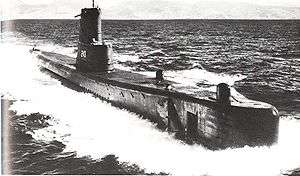USS Bream
USS Bream (SS/SSK/AGSS-243), a Gato-class submarine, was the first ship of the United States Navy to be named for the bream.
 | |
| History | |
|---|---|
| Builder: | Electric Boat Company, Groton, Connecticut[1] |
| Laid down: | 5 February 1943[1] |
| Launched: | 17 October 1943[1] |
| Sponsored by: | Mrs. Wreford G. Chapple |
| Commissioned: | 24 January 1944[1] |
| Decommissioned: | 31 January 1946[1] |
| Recommissioned: | 5 June 1951[1] |
| Decommissioned: | 10 September 1952[1] |
| Recommissioned: | 20 June 1953[1] |
| Decommissioned: | 28 June 1969[1] |
| Stricken: | 28 June 1969[1] |
| Fate: | Sunk as a target off California, 7 November 1969[2] |
| General characteristics | |
| Class and type: | Gato-class diesel-electric submarine[2] |
| Displacement: | |
| Length: | 311 ft 9 in (95.02 m)[2] |
| Beam: | 27 ft 3 in (8.31 m)[2] |
| Draft: | 17 ft (5.2 m) maximum[2] |
| Propulsion: |
|
| Speed: | |
| Range: | 11,000 nmi (20,000 km) surfaced at 10 kn (19 km/h)[6] |
| Endurance: |
|
| Test depth: | 300 ft (90 m)[6] |
| Complement: | 6 officers, 54 enlisted[6] |
| Armament: |
|
History
World War II
Bream was laid down on 5 February 1943 by the Electric Boat Co., Groton, Conn.. She was launched on 17 October 1943 (sponsored by Mrs. Wreford G. Chapple, wife of the prospective commanding officer), and commissioned on 24 January 1944, with Commander (Cmdr.) Wreford "Moon" Chapple (USNA Class of 1930) in command.
Bream's war operations extended from 1 June 1944 to 15 June 1945. During this period she completed six war patrols operating in the Java, Celebes, Sulu, and South China Seas and the Gulf of Siam. She sank two Japanese vessels totaling 6,934 tons.
In addition, Bream shared with Ray and Guitarro the destruction of a 6,806 ton passenger/cargo vessel. On 23 October 1944, while patrolling off western Luzon, Bream made a daring surface attack on a Japanese formation, damaging the heavy cruiser Aoba.

(from "U.S. Warships of World War Two").
Bream got underway from Saipan for Pearl Harbor 6 June 1945 en route to the United States for navy yard overhaul. She arrived at San Francisco 24 June 1945 and was undergoing overhaul when the war ended. She was placed out of commission in reserve 31 January 1946 and laid up in the Pacific Reserve Fleet.
Post war
Bream was recommissioned 5 June 1951 and reported to Submarine Squadron 3, Pacific Fleet. From June 1951 to August 1952 Bream engaged in type training and services to the Fleet Sonar School, San Diego. On 10 September 1952 she went out of commission in reserve at San Francisco. Bream was converted to an anti-submarine "hunter-killer submarine" and reclassified SSK-243, 18 February 1953.
Following recommissioning 20 June 1953, Bream participated in all phases of peacetime submarine operations in the Pacific Ocean. She conducted an Alaskan training cruise in September 1954, returning to San Diego 5 November 1954 via Pearl Harbor. Bream carried out operations off California until she made another trip to Pearl Harbor during 7 – 24 May 1955. Her next departure from the West Coast was on 6 March 1956 for a cruise in the Western Pacific, which terminated at San Francisco in early 1957.
Bream was reclassified Auxiliary Submarine AGSS-243, 1 February 1964.
Decommissioned on 28 June 1969, she was stricken from the Naval Vessel Register and sunk as a target 7 November 1969 by Sculpin (SSN-590).
Awards
Bream was awarded four battle stars for her World War II service.
References
- Friedman, Norman (1995). U.S. Submarines Through 1945: An Illustrated Design History. Annapolis, Maryland: United States Naval Institute. pp. 285–304. ISBN 1-55750-263-3.
- Bauer, K. Jack; Roberts, Stephen S. (1991). Register of Ships of the U.S. Navy, 1775-1990: Major Combatants. Westport, Connecticut: Greenwood Press. pp. 271–273. ISBN 0-313-26202-0.
- Bauer, K. Jack; Roberts, Stephen S. (1991). Register of Ships of the U.S. Navy, 1775–1990: Major Combatants. Westport, Connecticut: Greenwood Press. pp. 275–280. ISBN 978-0-313-26202-9.
- U.S. Submarines Through 1945 p. 261
- U.S. Submarines Through 1945 pp. 305–311
- U.S. Submarines Through 1945 pp. 305-311
This article incorporates text from the public domain Dictionary of American Naval Fighting Ships. The entry can be found here.